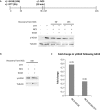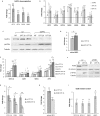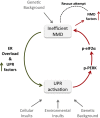The unfolded protein response affects readthrough of premature termination codons
- PMID: 24705877
- PMCID: PMC4023889
- DOI: 10.1002/emmm.201303347
The unfolded protein response affects readthrough of premature termination codons
Abstract
One-third of monogenic inherited diseases result from premature termination codons (PTCs). Readthrough of in-frame PTCs enables synthesis of full-length functional proteins. However, extended variability in the response to readthrough treatment is found among patients, which correlates with the level of nonsense transcripts. Here, we aimed to reveal cellular pathways affecting this inter-patient variability. We show that activation of the unfolded protein response (UPR) governs the response to readthrough treatment by regulating the levels of transcripts carrying PTCs. Quantitative proteomic analyses showed substantial differences in UPR activation between patients carrying PTCs, correlating with their response. We further found a significant inverse correlation between the UPR and nonsense-mediated mRNA decay (NMD), suggesting a feedback loop between these homeostatic pathways. We uncovered and characterized the mechanism underlying this NMD-UPR feedback loop, which augments both UPR activation and NMD attenuation. Importantly, this feedback loop enhances the response to readthrough treatment, highlighting its clinical importance. Altogether, our study demonstrates the importance of the UPR and its regulatory network for genetic diseases caused by PTCs and for cell homeostasis under normal conditions.
Figures









Similar articles
-
Nonsense-mediated mRNA decay affects nonsense transcript levels and governs response of cystic fibrosis patients to gentamicin.J Clin Invest. 2007 Mar;117(3):683-92. doi: 10.1172/JCI28523. Epub 2007 Feb 8. J Clin Invest. 2007. PMID: 17290305 Free PMC article.
-
Synergy between Readthrough and Nonsense Mediated Decay Inhibition in a Murine Model of Cystic Fibrosis Nonsense Mutations.Int J Mol Sci. 2020 Dec 31;22(1):344. doi: 10.3390/ijms22010344. Int J Mol Sci. 2020. PMID: 33396210 Free PMC article.
-
Nonsense-mediated mRNA decay and cystic fibrosis.Methods Mol Biol. 2011;741:137-54. doi: 10.1007/978-1-61779-117-8_10. Methods Mol Biol. 2011. PMID: 21594783
-
Nonsense suppression therapies in human genetic diseases.Cell Mol Life Sci. 2021 May;78(10):4677-4701. doi: 10.1007/s00018-021-03809-7. Epub 2021 Mar 22. Cell Mol Life Sci. 2021. PMID: 33751142 Free PMC article. Review.
-
Nonsense suppression therapies in ocular genetic diseases.Cell Mol Life Sci. 2015 May;72(10):1931-8. doi: 10.1007/s00018-015-1843-0. Epub 2015 Feb 5. Cell Mol Life Sci. 2015. PMID: 25651836 Free PMC article. Review.
Cited by
-
Nonsense-mediated RNA decay and its bipolar function in cancer.Mol Cancer. 2021 Apr 29;20(1):72. doi: 10.1186/s12943-021-01364-0. Mol Cancer. 2021. PMID: 33926465 Free PMC article. Review.
-
Decreased mRNA and protein stability of W1282X limits response to modulator therapy.J Cyst Fibros. 2019 Sep;18(5):606-613. doi: 10.1016/j.jcf.2019.02.009. Epub 2019 Feb 23. J Cyst Fibros. 2019. PMID: 30803905 Free PMC article.
-
Cystic fibrosis genetics: from molecular understanding to clinical application.Nat Rev Genet. 2015 Jan;16(1):45-56. doi: 10.1038/nrg3849. Epub 2014 Nov 18. Nat Rev Genet. 2015. PMID: 25404111 Free PMC article. Review.
-
Nonsense-mediated mRNA decay: novel mechanistic insights and biological impact.Wiley Interdiscip Rev RNA. 2016 Sep;7(5):661-82. doi: 10.1002/wrna.1357. Epub 2016 May 13. Wiley Interdiscip Rev RNA. 2016. PMID: 27173476 Free PMC article. Review.
-
Control of gene expression through the nonsense-mediated RNA decay pathway.Cell Biosci. 2017 May 19;7:26. doi: 10.1186/s13578-017-0153-7. eCollection 2017. Cell Biosci. 2017. PMID: 28533900 Free PMC article. Review.
References
-
- Ahnesorg P, Smith P, Jackson SP. XLF interacts with the XRCC4-DNA ligase IV complex to promote DNA nonhomologous end-joining. Cell. 2006;124:301–313. - PubMed
-
- Austin RC. The unfolded protein response in health and disease. Antioxid Redox Signal. 2009;11:2279–2287. - PubMed
-
- Bartoszewski R, Rab A, Twitty G, Stevenson L, Fortenberry J, Piotrowski A, Dumanski JP, Bebok Z. The mechanism of cystic fibrosis transmembrane conductance regulator transcriptional repression during the unfolded protein response. J Biol Chem. 2008;283:12154–12165. - PubMed
Publication types
MeSH terms
Substances
Grants and funding
LinkOut - more resources
Full Text Sources
Other Literature Sources

